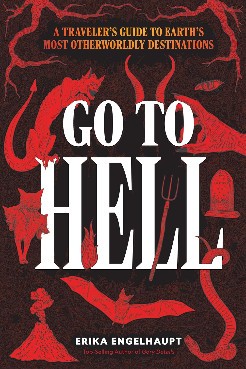This is a book about the most hellish places on Earth—in a good way. I add that last bit because when I tell people that I’m writing about hellish places, they tend to squint, tilt their head, and say something like, “Like Phoenix?” Or, if they’re New Yorkers: “Like New Jersey?” And then I say no, I’m not talking about hellholes—and for the record, I think both Phoenix and New Jersey have their selling points—but places that have some connection to the underworld as imagined by people and cultures throughout history.
This book is filled not with places you wouldn’t want to go, but with hells that, I hope, you will soon want to see for yourself.
So, yes, this is a travel book about going to hell. And I can see why that might sound like an oxymoron. Perhaps you assume the point of traveling is to experience something as close to heaven on Earth as possible—say, gazing at azure waters while reclining on a cloud of fluffy white pillows. That certainly sounds like a lovely vacation. At least for a couple of hours, and then the pillows start to go a bit flat, you find yourself shifting around uncomfortably, and all that endless blue is a tad monotonous, no?
Before you know it, you’re trying to remember if you left the oven on, or whether the hotel has a bar. Because let’s face it: Heaven can get a little boring. A book of the world’s most heavenly places runs the same risk as a bottomless bowl of whipped cream: perfectly nice, but after the first couple bites, you’ve pretty much got the idea.
Hell, on the other hand, presents itself in endless varieties—and they’ll keep you on your toes. You might find yourself peeking over the edge of a crater into a lake of fire (see here), climbing through dark caverns in search of Hades (see here), or hiking through an otherworldly expanse of volcanic landscape (see here). Or you could explore lore involving castles, ghosts, monsters, evildoers, heroes, spirits, or gods. You might even find the world around you glowing, boiling, steaming, glittering, or flaming.
So if any of that piques your interest, and you’d like to add a little spark and sizzle to your world travels—say, in the form of fire and brimstone—I have some ideas for you.
After all, some of Earth’s most awe-inducing sights have inspired hellish lore. Dramatic mountains and volcanoes, gorges and caves have long been considered boundaries between the realms of earth, air, and water. These liminal spaces, these gaps between worlds, are just the kinds of hidden places that the imagination tends to populate with the supernatural. Wherever earth breathes fire, ground shakes, foul gases spew, or rivers and lakes disappear mysteriously, people have said that the gods of the underworld must be at work.
Some of these places can be dangerous, even scary, but many are also breathtakingly beautiful. Caves are full of sparkling wonders (and crystallized fossils), volcanoes are draped in glowing red—or blue—and froths of steam top colorful pools of water. There are vast, stunning landscapes and small, intimate spaces where the faithful can contemplate the eternal.
A hell-themed world tour also provides a fascinating window into human history. People have always wondered what lies beyond life and death, and every culture and religion has formulated its own answers to this ultimate question. Seeing the similarities and differences in our versions of the afterlife tells us a lot about how human culture has spread across the globe and adapted to the different environments and phenomena that people encountered.
